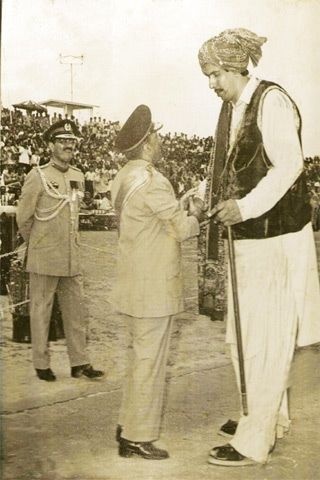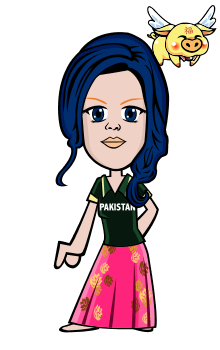
According to the Guinness Book of World Records, the tallest living man in the world (between 1982 and 1998), was Pakistan’s Mohammad Alam Channa. Before his death in 1998, Channa was reported to be 7ft 7 inches tall.
Born in 1953 in the city of Sehwan (in Pakistan’s Sindh province), Channa is said to have stood 6ft 4 inches by the time he was 18. He continued to grow taller till he was 26.
Channa came from an impoverished Sindhi family. He did not receive any noteworthy education. The male members of his family had traditionally served as minor retainers at the famous shrine of Sufi saint, Lal Shahbaz Qalandar, in Shewan. Here is where Channa too spent most of his years, tasked to keep certain areas of the shrine clean.
Alam Channa passed away many years ago, but one of his last wishes remains to be fulfilled
The annual urs (death anniversaries) of Sufi saints across South Asia are celebrated in a rather festive manner because since Sufi saints are considered to be ‘the beloveds of God’, their departure from earth is considered to be a visal (or when they are finally united with their beloved).
For centuries the urs of Lal Shahbaz has been a vibrant, festive and boisterous occasion.
Ever since the 1950s, travelling circuses (in Sindh) have also become mainstays in the area around the shrine where the festivities take place. It was the owner of one such circus stationed outside the shrine during the urs of 1978, who offered Channa a job in the circus.
According to Channa’s paternal side of the family (who I happened to meet in the late 1980s and then again in the early 1990s), Channa was making just Rs. 15 a week at the shrine! So when the circus offered him Rs. 160 a month, he decided to immediately accept the offer.
The circus turned Channa into a local star. He would travel with it across the length and breadth of Sindh. All he had to do was to make an entry just when two short men dressed as jokers were going through their routine. He would walk in and proceed to lift up the jokers (who would pretend to run away from the giant). Channa would grab them and then put them on his shoulders.
In 1981 a man who had watched Channa at the circus wrote a letter to the editors of the famous Guinness Book of World Records. With the letter he also sent some photos of Channa he had taken at the circus.
Months later some officials from Guinness landed in Sindh’s capital city, Karachi, and from there they reached Sehwan where they met and measured Channa.
They measured him at being 7ft 7 inches. On their return to the UK, the men entered Channa’s name in the Guinness book as the tallest living human on earth.
The news was first broken by local Sindhi newspapers. It was then picked up by a number of large Urdu and English language papers and then finally read in the main 9 pm Urdu news bulletin on the state-owned Pakistan Television (PTV).
Almost overnight Channa had become a well-known name. He began being chased by media personnel and onlookers wherever he went. Distressed by the kind of attention he had begun to attract, Channa quit the circus and retreated to becoming a minor retainer at the shrine.
He was still working at the shrine when in August 1983, a widespread protest movement erupted across Sindh against the dictatorship of General Ziaul Haq.
To prove that the protests were largely the work of a ‘handful of traitors’, Zia decided to tour all the hot spots of the province. But he continued to face protests, pebbles and stones wherever his helicopter landed.
In September 1983 after he had to hastily conclude one such trip (that he made to the violence-hit city of Dadu), Zia’s advisors in Sindh suggested that he met with ‘Sindh’s latest pride,’ Alam Channa (for a photo session).
Some government officials (escorted by a dozen or so policemen), quietly arrived at Channa’s small house in Sehwan. They did not go to the shrine because the shrine had become a meeting point of anti-Zia activists.
Someone told Channa that cops were waiting for him outside his house. Channa was almost entirely apolitical so he could not understand why there were cops stationed outside his home. He stayed put at the shrine until told by a messenger that the government was inviting him to receive an award from the ‘President.’
Cahnna walked back home and met the officials, who asked him to accompany them to Karachi. He shrugged his shoulders and agreed. He was to be picked up the next evening and driven to Karachi.
However, once the officials had left, Channa and his family were visited by a group of Sindhi nationalists. They asked him about his meeting with the officials and then told that since Sindhis were being oppressed by Zia, he must refuse to meet him.
Channa again shrugged his shoulders and agreed. The next morning he walked to work to the shrine as he always did. He stayed there doing his chores till late in the evening. The officials had arrived at his house, but after waiting in the area for hours, they returned to Karachi empty-handed.
No one knows what Zia was told. But it seems his obsession to meet the famous Sindhi remained intact.
In 1985 Zia once again exhibited his desire to be photographed with Channa. By now Channa had begun to be invited to various events abroad. He had truly become a star. But when in Sehwan, he would still walk to the shrine and do exactly what he had always done.
In March 1985, he was visited again by some government officials (this time without the police escort). They invited him to receive a special award from Zia during the parade ceremony on Pakistan’s Republic Day on March 23.
On 21st March he was driven to Karachi and then flown to Islamabad. There, during the award-giving ceremony, and in front of thousands of spectators, he received an award from Zia and a photographer captured the occasion for the press.



